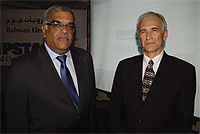International Comfort Products and Bahwan launch the Tempstar brand of commercial air conditioners in Muscat technical seminar
Bahwan Electronics and AHI Carrier on February 23 jointly launched the Tempstar brand of commercial air conditioners in Muscat during a technical seminar at the SAS Radisson Hotel, Muscat.
Tempstar is a brand owned by United Technologies Corporation (UTC) and is manufactured by International Comfort Products (ICP). Bahwan Electronics, a part of the Suhail Bahwan Group, is the distributor of Tempstar products in Oman.

Jayaprakash Menon and Colin Perkins
Giving the introductory speech, Jayaprakash Menon, the General Manager of Bahwan Electronics, spoke of a common aspiration to protect the earth for future generations. Pointing out to dire predictions that the earth would not be the same in 50 years’ time, Menon said one of the biggest environmental concerns was refrigerant gases. “To counter that, scientists have come up with green gases,” Menon said. “Tempstar’s range of air conditioners use green refrigerants, which can cut ozone depleting emissions by 30%.”
Speaking after Menon, ICP’s Manager for Export Sales, Colin Perkins, said that ICP, as a part of UTC, has embraced a corporate culture of environmental stewardship, under which it has embarked on a new fouryear programme to reduce greenhouse gas emissions by 12%, water consumption by 10% and non recyclable waste by 30%, all on an absolute basis as compared to the previous years.
Under the environmental stewardship programme, Perkins said, UTS was the first major corporation to offer the R410A refrigerant. This was in 1994. Subsequently, in 2006, Tempstar introduced R410A models into the US market.
In his presentation, Perkins pointed out that though the Montreal Protocol allowed the continued use of R22 through 2030 in developing nations, there were indications that many of them were taking steps to voluntarily change to environmentally friendly refrigerants. The UAE, for instance, was considering an accelerated phase-out of R22. And Latin America and the countries of the Caribbean were moving towards R410A. The R410A, Perkins said, is an azeotropic mixture. It does not segregate or stratify during off cycles, which is the case with zeotropic blends.
The R410A, Perkins added, is more efficient than R22 or similar-performance, “drop-in” zeotropic blends. Elaborating on its efficiency, Perkins said that the R410A has 31% more heat-carrying capacity in the vapour phase; 30% higher heat transfer coefficients; and a higher operating pressure (50-70% more), which equals higher gas density.
Keeping in mind the higher operating pressure and also its properties, though, R410A units require different components, Perkins admitted. For instance, they need new condenser coils, re-sized expansion devises, less system refrigerant and new specially designed compressors. The Tempstar R410A systems, Perkins said, use scroll compressors. The thicker casing of the compressors is able to tolerate higher pressures and temperatures, he added.
Saying that ICP has been active in the Gulf Region for 25 years, of which 19 years have been with the Tempstar brand, Perkins then elaborated on the specific range of products the company was launching in Oman, including split-system condensers (1.5-5 TR) and package rooftops.
The company’s split-system condenser, R4AE, Perkins said, has a 13+ SEER rating. As standard features, it has scroll compressors, high pressure switch, low-pressure switch, filter drier, phase monitor, and corrosion-resistant, polymer-coated coil. The split systems, Perkins said, are specifically designed for high ambient (52ºC) and severe climatic conditions.
Speaking, then, on the company’s packaged rooftop systems (RAS), which come in nine models, ranging from five to 20 TR, Perkins said, they are ASHRAE 90.1 compliant and boast of standard EERs from 9.9 to 12.3 at ASHRAE rating points.
The rooftop systems, Perkins said, have precisionsized scroll compressor, low and high pressure protection, no-strip screw technology and a non corrosive condensate pan (which meets ASHRAE 62 guidelines). Further, the systems have easy-access handled panels, larger and centralised control box, command centre terminal board, flexible belt-drive fan and a 75VA transformer with circuit breaker. Among the different models of the rooftop system, the 17-2o TR models have as standard features an extended bearing lube line, a dedicated vertical duct-configuration model, a dedicated horizontal (S/S) duct-configuration model and slide-out filter tracks.
Generally speaking, the rooftop systems, Perkins said, come with several factory-installed options, including temperature and enthalpy economiser, nonfused disconnect, multiple fan motors and drives, twoposition motorised damper, manual damper, smoke detectors (return air, supply air, or both), CO2 sensor, louvred hail guard, coated coils and centrifugal power exhaust.
The seminar was also attended by Jafar Imam, Regional Manager (RLC), AHI Carrier.
Copyright © 2006-2025 - CPI Industry. All rights reserved.